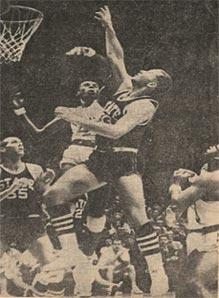Unless you're over the age of fifty or live in Utah chances are you haven't heard of Wayne Estes. In the early to mid-1960s many observers labeled him one of the best shooters in college basketball. Estes mastered the rare ability of versatile perimeter shooting as he was capable of making shots from anywhere on the floor.
 |
|
Wayne Estes in Action
|
Heading into his senior year Estes was always mentioned along with future NBA draftees, Rick Barry, Gail Goodrich, Bill Bradley and Billy Cunningham, in various media publications when devising All-American teams. Many who knew Estes off the court said that his small town demeanor and humble personality made him an instant hit with students, faculty, and newspaper syndications in the Southwestern part of the country. Estes led Utah State to two straight NCAA tournament berths, which is an impressive feat for any school at the time as the NCAA did not grant at-large bids. Only conference winners were selected.
Although his last game was played some forty plus years ago, Estes remains Utah State's number two scorer and third best rebounder of all time. For those who remain skeptical of his greatness consider this - Joe Caldwell was the #2 pick of the 1964 NBA draft. Estes played in the 1963 and 1964 NCAA tournaments where he meet Caldwell on both occasions. Although Estes was two years younger he more than held his own against Caldwell, as he averaged 35 points and 8.5 rebounds per game in those match-ups.
Estes' skills made him a big target for the NBA and it seemed highly unlikely that he would last past the first two rounds of the 1965 NBA Draft, but what would happened next could be played out in the script of a Hollywood drama.
The Problem
February 8th, 1965 was a special night for Estes and all that knew him. Heading into the game against Denver University, Estes needed 47 points to reach the exclusive 2,000 point plateau. It was a game that needed to go right for Utah State as they were suffering through a rough 6 game losing slump. Despite the tough defense that was played where the opposing team ran three defenders at Estes and often attempted to apply various double teams, he scored 48 points. The nation’s number two scorer behind Rick Barry had to feel like he was on top of the world as he called his parents back home in Montana to tell of his impressive feat.
But just two hours after the game of his life, Wayne Estes lost his life. On his way back to campus with his roommate, Delano Lyons, and teammates, John Vassey and Tim Smith, they came across a bad accident at an intersection. The group decided to stop at the scene and run over to take a gander at the mangled vehicle.
Unfortunately, the wreckage included a dangling power line. In Estes' rush to view the scene his forehead brushed the live line and he was electrocuted. It is unknown how many volts went through Estes' body, but as his roommate, Lyons, attempted to save him, he was hurled across the across the street from the massive electrical shock that came from Estes' body.
Police officers on the scene immediately gave Estes CPR but it was to no avail. He was pronounced dead at the scene. This devastating loss was felt on the Utah State campus and across the nation. It's been said that there was not a dry-eyed young man in the Southwest that night as they learned that their hero had passed.
Conclusion
This is an age were people can sometimes view an athlete as self absorbed, shallow, or a head case, but Estes' rise to the NBA was not cut short because of immaturity or an immoral deed. He was simply curious about a car wreck.
Archived newspaper articles from 1965 report that Estes' death contained an irony, as it's mentioned that his 6-6 stature played a major part in his demise. It was determined that if Estes were of average height he would have been able to safely walk under the power line. To this day the friends and alumni who went to bed that night with tears in their eyes still remember Estes fondly.
The Draft Review applauds Estes for his collegiate accolades and recognizes him as a player that should have been a part of the 1965 NBA draft class. We include Wayne Estes in our list of honorable draftees.
